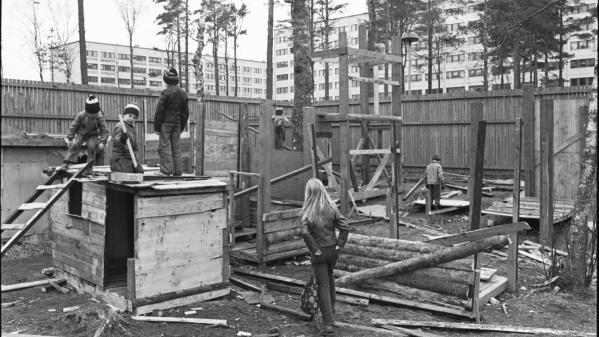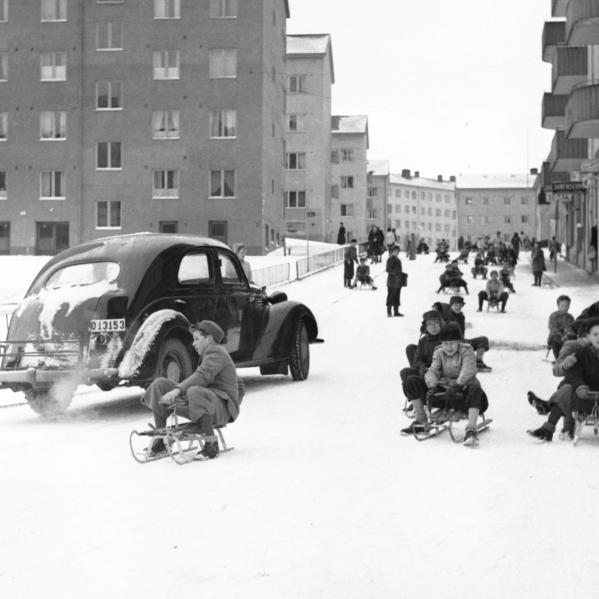Free play!

Photo: Jens S. Jensen. From the archive of The Museum of Gothenburg.
A playful life
Play is most often associated with children. Because children's play can be seen and heard! Children play as much as they can and they play almost anywhere. For the child, play is vital – a child who cannot or does not want to play needs help. Playing follows us throughout life – it just takes on different expressions.
The little child plays for themself with the available things. They test how the immediate environment works with an adult within reach. After a few years, the child plays with other children and explores what reality and imagination are together with playmates. Places where children themselves can influence, stimulate and develop games, where the child and the environment interact. After a few more years, the child embarks on a journey of discovery and explores how the boundaries and rules of the game work. At the end of childhood, the child searches for their own identity. Belonging to a group is then important.
The young person, like everyone else, wants to be seen and look at others, but also to be able to withdraw and be solitary. It is especially important when young people develop their identity by trying what it is like to be and act in different ways. The adult world often perceives the subcultures that arise as threatening. The subcultures question the rules and lifestyle of adults and the adult world's response is, therefore, to try to control them in different ways.
But adults also need to play! Unfortunately, it is not often that adults let go of control and indulge in spontaneous play. Play can in many ways seem to be the exact opposite of adults' way of life. Is that why adults sometimes look down on the play and think it is unimportant?
Adults may call their play a creative hobby – or they may play by testing a new identity at parties or events. The desire to play probably remains throughout life, but it can be inhibited. Maybe adults just think that play is not suitable for certain professional roles or is good for one's status?

A playful city
The built playground often symbolises play in the city. The playground signals that children are welcome here. But what does the playground say about the view of play? Which places are the best playgrounds? Is the playground needed - or is the time ripe to plan, design and develop the entire city for and together with children and youth?
Playing does not require expensive play equipment. Nature or areas with trees and shrubs often provide unbeatable opportunities for ingenuity. Sticks, stones and other finds can be used to build and become props in the game. In natural environments, the roles are not predetermined and all children can join in and find a task. Surveys show that up to the age of seven, girls and boys use the public space equally, but then the boys dominate 80 percent of the places. Since play is just as important for girls as it is for boys, this is serious.
It is important to plan so that children and young people can move freely in the city. The older children get, the further from home they should be able to get on their own. It contributes to a young person growing up into an independent individual with knowledge of their entire city.
On the traditionally built playground, the child or young person is expected to play in a certain way based on how the place and the equipment are designed. Studies have shown that children do not play for very long with ready-made play equipment. They get bored and try to develop the game into something more and different. Can you go up the slide instead of down? Does gravel roll down the chute as fast as a rock?
Through play, children investigate the laws of physics and the properties of materials. A good playground has both small and large surfaces and a variety of materials. There are both places to be active and places where you can retreat. There is the opportunity to influence what you can do yourself, as well as a variety of vegetation that provides both sun and shade. In order for all children to have equal access to good and developing play environments, knowledge of how to plan child-friendly is needed. Children's experiences and sensory experiences during growing up remain well into adulthood.
Do you yourself remember where you played as a child?

Children sledding down an unknown street in Gothenburg, February 1950. From the archives of The Museum of Gothenburg.
Play in Gothenburg
As early as the end of the 19th century, one of the country's first playgrounds was built in Gothenburg. Anna Branzell, Sweden's first woman with an architecture degree, and later Arvid Bengtsson, city gardener in Gothenburg 1962–1979, were both involved in children's play and thanks to them, Gothenburg got an early adventure playground.
Today, there are approximately three hundred playgrounds in Gothenburg, of which six are manned. In addition, there are two manned activity sites and the popular animal park The Children's Zoo in Slottsskogen, where visitors can get up close and personal with the park's land breeds. If you photograph the QR code below, you can see where all the city's playgrounds are. You can search for playgrounds that are accessible, have a toilet or are close to, for example, a swimming pool or a forest.
The City of Gothenburg wants to be a playful city where play can take place. A playground should first and foremost be fun and educational, but it is also a place with great social values where children and parents from the surrounding area meet. Playgrounds also function as a meeting point between neighbourhoods and thus contribute to integration.
Those who plan playgrounds in Gothenburg like to place them near nature or a park so that the play can continue outside the playground. In this way, both adults and children are given the chance to experience nature. Trees provide shade and coolness on hot summer days, and in natural vegetation, we become aware of seasonal changes, come into contact with plants and animals and have access to play materials. Many playgrounds have a cultural-historical value as they have existed for a long time and have names that have lived on for generations. The Plikta playground, for example, has existed since 1920 and is Gothenburg's most famous playground. The Rain Playground is a new addition that pulled attention for its design, which makes it extra fun to play when it rains.
The City of Gothenburg has had guidelines for playgrounds since 2007. The latest one is from 2020 and has as its goal that everyone should have a playground close to them - wherever they live in the city. The City of Gothenburg has divided its playgrounds into four categories. Closer to the residence are the smaller area playgrounds and a little further away is the neighbourhood playgrounds with more play opportunities. The most lavish, and sometimes even manned, excursion playgrounds are scattered all over the city. All ages and generations will find something exciting to do and experience there.
But Gothenburg also highlights a fourth concept: play environment. After all, playing takes place everywhere children are: along the way to school, on the way to friends, in bushes and on mountain slopes. Highlighting the concept of a play environment is a statement of intent from the city. Gothenburg wants to be a city where play is accepted and wants to show a new way of relating to city planning where children are included.